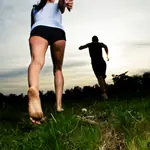
Always in search of the magic bullet, people tend to go to extremes when they hear of something promising. It happens with diets, with politics, and in this case, with shoes.
As "power running" became widespread in the '80s and '90s, running shoes grew clunkier and thicker. Shoe companies taught us that more cushioning equaled better protection. In reality, excess shoe inhibits our ability to feel impact and the subsequent damage we may be doing to our bones, joints and muscles with each step. Current studies show that the thicker the heel of the shoe, the earlier the foot comes into contact with the ground, increasing impact to the legs, knees and joints.
Chi Running has advocated for minimal shoes since 1999, but always with the caveat of one of Chi Running's main tenets: Gradual Progress. Putting on a pair of minimal shoes does not change years of movement patterns you have established. The idea that running without shoes or with a more minimal shoe will save you from injury is, in many cases, wishful thinking. The truth is running in minimal shoes or barefoot will give you form feedback that overbuilt shoes won't; the key to preventing injury lies in responding to this feedback by making adjustments to your technique.
For a healthy transition, follow these tips to avoid overuse injuries that can plague minimalist or barefoot runners:
1. Take it slowly and don't expect to be running your current mileage as you switch from your current shoes to barefoot running or minimalist shoes.
2. If you're transitioning to barefoot running, do it on a hard surface or a track and not on grass (contrary to popular opinion). Because grass offers such a soft surface, it can be difficult to tell if you're heel striking. Running on a hard surface will give you immediate form feedback and "force" you to land softly or suffer the pain.
3. If you go cold turkey and toss your old shoes in trade for minimalist or barefoot running, start by running very short distance intervals, such as 200m or less, just to see how it feels. Then, walk for the same distance. This helps toughen your feet without creating as much impact as running. Switch back and forth between walking and running as your body allows. The 10% increase rule applies here - start with very short runs and add no more than 10% of an increase in mileage (or time on your feet) in one week.
4. Be very cautious if you're switching to minimalist or barefoot running if your BMI is 25 or higher, as the increase of impact to unprotected feet magnifies significantly if you're overweight. If your BMI is 30+, you might consider losing some weight before switching to the minimalist approach. Try walking in minimalist shoes first and increase your mileage slowly. Measure your BMI with a BMI Calculator.
5. For at least the first month, do most, if not all, minimalist or barefoot runs on level ground, not on hills. Running uphill places increased stress on your Achilles tendons, while running downhill places more impact and stress on your plantar fascia, the soft tissues of the bottoms of your feet, your calves and your shins.
6. Make sure you are running with biomechanically correct running form on the first day of your switch to minimalist or barefoot running:
- Shorten your stride.
- Don't heel strike. Land midfoot.
- Keep your knees bent.
- Relax your lower legs throughout your stride cycle.
- Maintain good posture with a slight forward lean from the ankles.
When approached mindfully, there is no reason why anyone should suffer injury from switching to barefoot or minimalist running. Without the extra bulk and padding, your body will truly sense what the ground feels like and respond accordingly. Educate your feet gradually, and allow your body to adapt at its own pace.
Danny Dreyer is the creator of ChiRunning? and ChiWalking?, revolutionary forms of moving that blend T'ai Chi with running and walking.
ChiRunning and ChiWalking by Danny and Katherine Dreyer are No. 1 sellers with over 350,000 copies sold.
As an accomplished ultra marathoner, Danny speaks at prestigious wellness events across the country. He has taught training groups including the AIDS Marathon and Team in Training, USA/FIT. Danny, along with more than 135 Certified Instructors, holds capacity-filled clinics around the world.
Danny's lifestyle is steeped in holistic living, meditation, and personal wellness and is the foundation of what he teaches.? ChiLiving, Inc. 2011
Get ACTIVE on the Go


Couch to 5K®
The best way to get new runners off the couch and across the finish line of their first 5K.
Available for iOS | Android







Discuss This Article